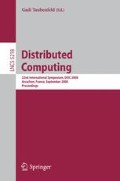Abstract
In [Dij74] Dijkstra introduced the notion of self-stabilizing algorithms and presented, among others, an algorithm with three states for the problem of mutual exclusion on a ring of processors. In this work we present a new three state self-stabilizing algorithm for mutual exclusion, with a tight bound of \(\frac{5}{6} n^2 + O(n)\) for the worst case complexity, which is the number of moves of the algorithm until it stabilizes. This bound is better than lower bounds of other algorithms, including Dijkstra’s. Using similar techniques we improve the analysis of the upper bound for Dijkstra’s algorithm and show a bound of \(3\frac{13}{18} n^2 + O(n)\).
Access this chapter
Tax calculation will be finalised at checkout
Purchases are for personal use only
Preview
Unable to display preview. Download preview PDF.
References
Beauquier, J., Debas, O.: An optimal self-stabilizing algorithm for mutual exclusion on bidirectional non uniform rings. Proceedings of the Second Workshop on Self-Stabilizing Systems 13, 17.1–17.13 (1995)
Burns, J.E., Gouda, M.G., Miller, R.E.: On relaxing interleaving assumptions. In: Proceedings of the MCC Workshop on Self-Stabilizing Systems, MCC Technical Report No. STP-379-89 (1989)
Beauquier, J., Johnen, C., Messika, S.: Brief announcement: Computing automatically the stabilization time against the worst and the best schedules. In: Dolev, S. (ed.) DISC 2006. LNCS, vol. 4167, pp. 543–547. Springer, Heidelberg (2006)
Cobb, J.A., Gouda, M.G.: Stabilization of general loop-free routing. Journal of Parallel and Distributed Computing 62(5), 922–944 (2002)
Chang, E.J.H., Gonnet, G.H., Rotem, D.: On the costs of self-stabilization. Information Processing Letters 24, 311–316 (1987)
Chernoy, V., Shalom, M., Zaks, S.: On the performance of Dijkstra’s third self-stabilizing algorithm for mutual exclusion. In: 9th International Symposium on Stabilization, Safety, and Security of Distributed Systems (SSS), Paris, November 2007, pp. 114–123 (2007)
Chernoy, V., Shalom, M., Zaks, S.: On the performance of Beauquier and Debas’ self-stabilizing algorithm for mutual exclusion. In: Shvartsman, M.M.A.A., Felber, P. (eds.) SIROCCO 2008. LNCS, vol. 5058, pp. 221–233. Springer, Heidelberg (2008)
Chernoy, V., Shalom, M., Zaks, S.: A self-stabilizing algorithm with tight bounds for mutual exclusion on a ring. Technical Report CS-2008-09, Department of Computer Science, Technion, Haifa, Israel (July 2008)
Dijkstra, E.W.: Self stabilizing systems in spite of distributed control. Communications of the Association of the Computing Machinery 17(11), 643–644 (1974)
Dijkstra, E.W.: A belated proof of self-stabilization. Distributed Computing 1, 5–6 (1986)
Dolev, S.: Self-Stabilization. MIT Press, Cambridge (2000)
Kessels, J.L.W.: An exercise in proving self-stabilization with a variant function. Information Processing Letters 29, 39–42 (1988)
Kruijer, H.S.M.: Self-stabilization (in spite of distributed control) in tree-structured systems. Information Processing Letters 8, 91–95 (1979)
Nakaminami, Y., Kakugawa, H., Masuzawa, T.: An advanced performance analysis of self-stabilizing protocols: stabilization time with transient faults during convergence. In: 20th International Parallel and Distributed Processing Symposium (IPDPS 2006), Rhodes Island, Greece, April 25-29 (2006)
Tsuchiya, T., Tokuda, Y., Kikuno, T.: Computing the stabilization times of self-stabilizing systems. IEICE Transactions on Fundamentals of Electronic Communications and Computer Sciences E83A(11), 2245–2252 (2000)
Author information
Authors and Affiliations
Editor information
Rights and permissions
Copyright information
© 2008 Springer-Verlag Berlin Heidelberg
About this paper
Cite this paper
Chernoy, V., Shalom, M., Zaks, S. (2008). A Self-stabilizing Algorithm with Tight Bounds for Mutual Exclusion on a Ring. In: Taubenfeld, G. (eds) Distributed Computing. DISC 2008. Lecture Notes in Computer Science, vol 5218. Springer, Berlin, Heidelberg. https://doi.org/10.1007/978-3-540-87779-0_5
Download citation
DOI: https://doi.org/10.1007/978-3-540-87779-0_5
Publisher Name: Springer, Berlin, Heidelberg
Print ISBN: 978-3-540-87778-3
Online ISBN: 978-3-540-87779-0
eBook Packages: Computer ScienceComputer Science (R0)

